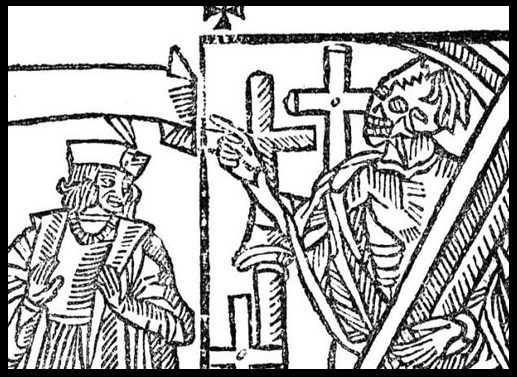
Everybody by Branden Jacobs-Jenkins
directed by KT Turner
dramaturgy by Ariana Burns
(Section of frontispiece from edition of Everyman published by John Skot c. 1530.)
Clare Wright’s thesis, Sound, Body and Space: Audience Experience in Late Medieval English Drama, got me thinking about the medieval audiences in the High Middle Ages. There isn’t a lot of information on attendees of morality plays but what is available is interesting. The audience is an important participant in theatre. More recently, scholars have been researching play attendees and their role in the process of theatre and sharing stories.
Three things I found noteworthy:
Obligatory caveat: These are not unique to this time period, but I think their presence effected audience interaction with morality plays and are something to have in mind when thinking about Everyman.
During the Middle Ages, people were focused on the soul;
literacy was not the priority it is nowadays;
reading was performed aloud as a communal experience, though it could be a private one.
Wright reflected that in that Middle Ages the soul was more valuable than the body. It would abide with “God, heaven and eternal bliss” but the body would be cast aside at death (p 15). The body was also the entry point for both redemption and temptation.
On this reading, the body is not in opposition to the soul, but is instead the central means of accessing the divine and, despite its weaknesses could be used to achieve knowledge of God and an eternal resting place in heaven. But, given the infectious nature of sensory temptation …it was necessary to be vigilant…. (Carole Wright, p 21).
Towards this increased vigilance, the church wanted to increase religious devotion and spiritual education. Publishing pamphlets wasn’t going to be particularly successful. Literacy was at low levels, but being unable to read Latin or French wasn’t considered a deficiency then (Coleman, thesis, p 90). Tim White, writing for the British Library, explained that information was acquired through painted tapestries, sculptures, reading, and dramatic presentations.
“Individuals that we might now consider to be ‘illiterate’, in the sense that they could not read or write, could still possess sophisticated and detailed knowledge, not only of religious materials, but also of literary texts and traditions” (White).
In her essay about medieval audiences, Joyce Coleman explored how different classes of men and women made use of public reading as an activity. People gathered for the aural experience during meals, study, or entertainment (Coleman, p 161-164). Where we might find it a limiting experience, for them it was a source of variety:
Every medieval person, of every class and gender, would probably have heard many oral texts throughout their lives. Such material could include the lyrics of songs, poetry unaccompanied by music, popular romances, public oratory, and sermons and other forms of religious exhortation (Joyce Coleman, "Audience," p 161).
Oral texts were an efficient way for the church to communicate and have a transformative effect on their flock. Also, like performance, the act of involvement in an oral text (either by reading or listening) bound them together in a shared event (Coleman, “Interactive,” p75). It was an immersive experience not singularly encountered through one sense organ. They could hear sound and feel it reverberate through their body. They could feel the emotions of the story related (Wright, p 14).
The audience’s experience of the event is not only mental but spiritual, emotional, and physical. It took them on a journey that stayed with them after the performance (Wright, p 237-242) and created both a common and a personal recollection as Cepek explained in her thesis:
In the Middle Ages, then, salvation history as communal memory is the premise on which most drama is based. The goal of most medieval religious drama is therefore to make these narratives as real as possible so that they become memory – the collective memory, of course, but individual memory as well.--Rebecca Cepek, p20
With the church looking to spiritual salvation, readings and dramatic presentations were effective tools to this end (Wright, p 29). The audiences were already familiar with them and they could be used for Biblical stories, education or showing that there was hope of salvation for all (Kalua, p 9).
Cepek, Rebecca. Stages Of Belief: The Nature Of Audience Response In Medieval And Early Modern Drama. Dissertation. Duquesne University. 2014.
Coleman, Joyce. “Audience” A Handbook of Middle English Studies, First Edition. Edited by Marion Turner. John Wiley & Sons, Ltd. 2013.
Coleman, Joyce. “Interactive Parchment: The Theory and Practice of Medieval English Aurality.” The Yearbook of English Studies, 1995, Vol. 25, Non-Standard Englishes and the New Media. Special Number, pp. 63-79. Modern Humanities Research Association. https://www.jstor.org/stable/3508818. Last Accessed: Jan 7, 2021.
Coleman, Joyce. The World’s Ear: The Aurality Of Late Medieval English Literature. Ph.D. thesis. University of Edinburgh. 1993.
Kaula, David. “Time and the Timeless in Everyman and Dr. Faustus” College English, Oct., 1960, Vol. 22, No. 1, pp. 9-14. Published by: National Council of Teachers of English. https://www.jstor.org/stable/373857. Last Accessed Dec 22, 2020.
Wertz, Dorothy. “Conflict Resolution in the Medieval Morality Plays,” The Journal of Conflict Resolution, Dec., 1969, Vol. 13, No. 4, pp.438-453. Sage Publications, Inc. https://www.jstor.org/stable/173563. Last Accessed: Jan 7, 2021.
White, Tom. British Library. www.bl.uk/medieval-literature/articles/experiencing-medieval-literature. 31 Jan 2018.
Wright, Clare. Sound, Body and Space: Audience Experience in Late Medieval English Drama. PhD thesis, University of Nottingham. 2011. Access from the University of Nottingham repository: http://eprints.nottingham.ac.uk/13108 /1/555408.pdf. Last accessed: Jan 1, 2021.